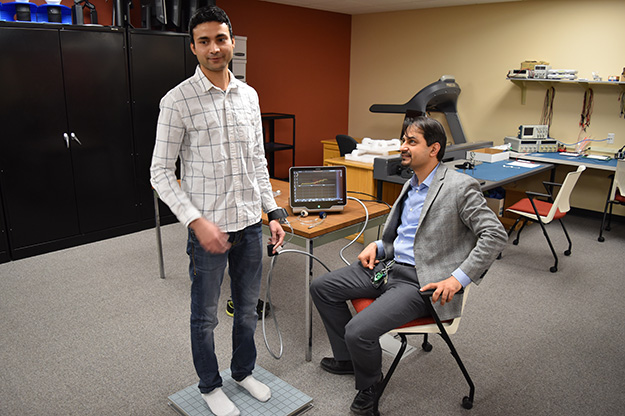Patents pending aplenty
Joint UND-NDSU biomedical engineering symposium showcases student and faculty collaborations

If You Go:
- What: The second annual joint UND-NDSU Biomedical Engineering Symposium
- Who: Students and faculty researchers from UND and NDSU along with industry representatives
- When: 9 a.m.-4 p.m., Monday, Oct. 22
- Where: Memorial Union on the campus of UND
New technology to monitor patients with Parkinson’s disease or concussion.
A device to monitor drowsiness in pilots.
A chamber that could help astronauts acclimate to Earth’s gravity before returning to the blue planet.
Cushions that adapt to patients in wheelchairs and help them avoid pressure ulcers.
These are all projects – many with patents pending – within the new biomedical engineering program, a collaborative initiative between UND and North Dakota State University.
Students and faculty at both universities will visit with industry leaders at the second annual UND/NDSU biomedical engineering symposium set for Monday, Oct. 22 at the UND Memorial Union.
“We want to see how we can collaborate with industry,” said Kouhyar Tavakolian, co-director of the biomedical engineering program at UND and assistant professor of electrical engineering & computer science.
He added that representatives from Mayo Clinic, Medtronic, Bio-Techne Corp. and others will attend.
Along with North Dakota’s large research universities working together, the program encourages students and faculty to collaborate with industry as well as engineering, biomedical sciences, nursing and other areas.
Get it together
Now in its second year, the program already is making an impact.
“We have a lot of professors and undergraduate students who are already doing biomedical research,” said Annie Tangpong, associate professor of mechanical engineering at NDSU and co-coordinator of the biomedical engineering graduate program. “There are a lot of students who want to enter biomedical engineering, along with needs in the local area and the state. UND has the medical school, NDSU has a bigger engineering program. We want to build on our strengths to collaborate and further develop the program.”
“The collaboration between UND and NDSU is a great thing,” Tavakolian said. “Students take courses from both universities, our professors collaborate, and we work with industry.”
The idea developed three years ago through the collaborative efforts of two engineering deans — UND’s Hesham El-Rewini and Gary Smith (NDSU’s engineering dean at that time) — along with Joshua Wynne, dean of UND’s School of Medicine & Health Sciences (SMHS). Reza Fazel-Rezai, with UND electrical engineering, and Dan Ewert, NDSU computer and electrical engineering, also played a major role in developing this joint program.
Fazel-Rezai served as UND’s director of the program until leaving on sabbatical for the current academic year.
“Working with Dean Gary Smith on a number of initiatives such as this was a pleasure,” said El-Rewini. “Michael Kessler [NDSU’s current engineering dean] and I have had to the opportunity to collaborate and meet together on a number of occasions and I look forward to developing more programs within our two colleges as we move forward with a vision for innovation.”
“I’m a big believer in breaking down silos to have true innovation,” said Ewert. “The problems we need to solve are far-reaching. The state has a lot of assets, and it would be a missed opportunity if we didn’t make something come together. We can give back to the state and taxpayers, and there is a tremendous opportunity for spinoffs, licensing and helping people.”

Student focus
Through it all, the program keeps students as its primary focus, said Ewert.
“What’s our purpose?” he asked. “Let’s give kids in small town North Dakota an opportunity. There are 100 reasons to do this and very few reasons not to do it.”
As part of the program, students take courses from both UND and NDSU as well as perform research. Doctoral students are also required to take internships with industry. That’s because most Ph.D. students do not enter academia, said Tavakolian.
Undergrads also have research projects.
“Diversity of thought drives innovation,” said Ewert. “As students demonstrate their learning through discovery, it will yield an unbelievable opportunity for the state of North Dakota.”
Projects in the mix
At UND, many of the projects involve medical devices and collaboration with SMHS and College of Nursing & Professional Disciplines.
A particular device that could help patients with Parkinson’s will be tested soon at Sanford Health in Fargo by a graduate student and Jau-Shin Lou, the Dr. Roger Gilbertson Endowed Chair of Neurology at SMHS and chair of Sanford’s neurology department in Fargo. Lou and Tavakolian are working together to evaluate technology that can help assess balance in patients with Parkinson’s disease and other conditions.
The equipment was built at UND, and will be used in Lou’s lab to study subjects with normal balance and see how it can apply to patients.
Also a project using sensors to detect drowsiness in pilots, along with a headset that can vibrate and wake them up, is close to commercialization, Tavakolian said.
Yet another project, part of a grant from the U.S. Department of Defense, mimics hemorrhaging sometimes seen in battlefield injuries as well as some postpartum deliveries. To simulate hemorrhaging, a special lower body negative chamber, used by astronauts to re-acclimate to Earth and gravity before returning to earth, is utilized.
Another project incorporates sensors in cushions for people in wheelchairs or who are bedbound. They sense and vary contact points to help prevent pressure ulcers, or bedsores. It’s being developed with the UND College of Nursing & Professional Disciplines, which has done research on pressure ulcers and prevention for decades. Darlene Hanson and Patricia Thompson, clinical associate professors of nursing, are working with Rashid Ahmed, associate dean for research, who handles statistical analysis for the project.
“We want to work with engineering and medicine to help the rural population in our state,” Ahmed said. “Technology and tele-health can support rural communities.”
He added that the projects align with the One UND Strategic Plan Grand Challenges in health and biomedical sciences and rural health.


